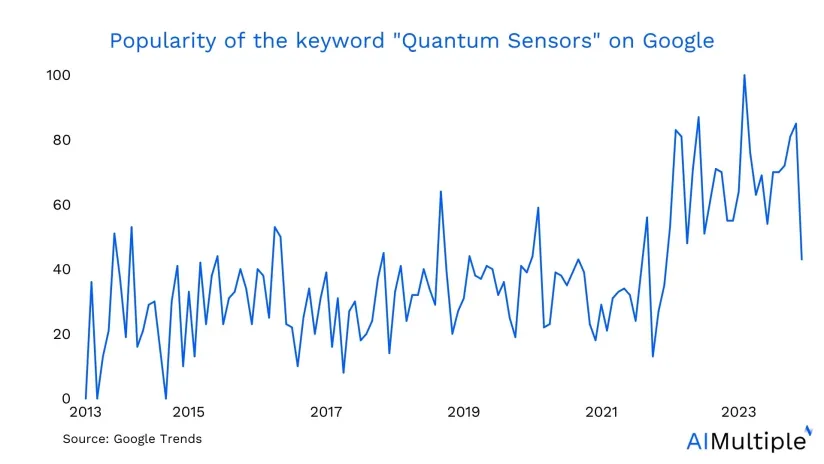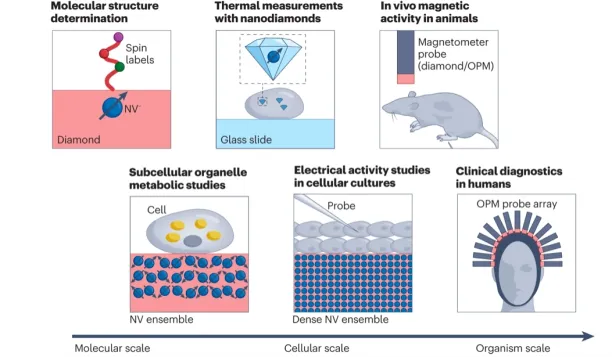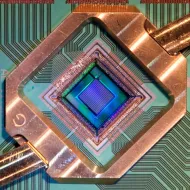Quantum Sensors in '24: Best 8 Use Cases & Case Studies


Quantum sensing is the most mature market across the quantum technology ecosystem.1 For example, MRI is an example of quantum sensing used for 50 years. However, given quantum sensors’ usefulness, precedence and potential, overall investment and the number of players in the market remain low.
Nevertheless, despite the low market players, recent advancements will provide accurate and intelligent measurement and signals. This is why the global quantum sensors market is expected to grow by 9% and reach $1020.8 million by 2030 2 , while public interest in the topic has steadily increased, as well (See cover Figure).
If you don’t wanna fall behind the curve, you should increase your knowledge of quantum sensing. Therefore, this article aims to inform executives and potential investors by explaining:
- What is it?
- How does it work?
- Top quantum sensor products types
- Most common use cases & case studies
- Top quantum sensor benefits
What is quantum sensing?
Quantum sensing is a technology using the principles of quantum mechanics to develop new types of sensors. It lies under the quantum technologies category along with quantum computing, quantum simulation, and quantum communication.
Quantum sensors are expected to have higher sensitivity, accuracy, and precision in their measurements of physical quantities, such as:
- Magnetic fields
- Electric fields
- Temperature
- Pressure
- Chemical composition.
For example, quantum sensors can measure the magnetic fields produced by the brain to diagnose neurological disorders. Learn some other examples of quantum sensors in this video:
How do quantum sensors work?
Quantum sensors combine sensor technology with quantum mechanics properties, quantum entanglement, quantum interference, and quantum state. Quantum sensors gather and carry information via quantum bits or qubits which refer to photons, ions, and neutral atoms.
Unlike quantum computers, quantum sensors benefit from fragile quantum states to sensitively measure the environment, such as changes in rotation, pressure, gravity, and magnetic or electric fields.
There are two common approaches to quantum sensing:
- First approach: Atoms and ions are trapped in a vacuum chamber and cooled to low temperatures. Then, they are manipulated with lasers to measure their physical properties while controlling their internal states.
- For example, while measuring the magnetic field, quantum sensors place a small sample of atoms and ions to be affected by the magnetic field. These atoms and ions will then split into different energy levels, which can be detected with a laser as they will shine. By tracing patterns of fluorescence, researchers will assess the strength and direction of the field.
- Second approach: Quantum sensors use individual photons’ properties to measure physical quantities.
- For example, sensors can measure the temperature with high precision by shining a laser beam and analyzing the intensity and wavelength of the scattered light.
Learn more about how quantum sensors work by watching:
What are the benefits of quantum sensing?
Quantum sensors can:
- Increase & improve sensitivity by detecting, measuring and distinguishing different types of physical quantities or chemicals with unprecedented sensitivity and high accuracy.
- Offer higher precision by making measurements with extremely high precision to offer accurate and detailed measurements of physical quantities.
- Ensure non-invasive measurement by providing an accurate measuring without physically touching the object, which can be crucial in certain applications, such as medical diagnostics.
- Enable fast response time by providing real-time measurements, allowing for immediate feedback and control in a variety of applications.
- Lead to new applications by evolving rapidly, with new sensing techniques and applications being developed all the time. This opens up new opportunities for scientific research, medical diagnostics, environmental monitoring, and more.
7 Types of quantum sensors
- Atomic clocks: Atomic clocks use the highly stable and predictable oscillations of atoms, such as cesium or rubidium atoms, to measure time with extreme accuracy. These clocks are applied to GPS navigation and scientific research.
- Magnetometers: Magnetometers use the properties of atoms or ions to measure magnetic fields in geology, medical diagnostics, and materials science.
- Gravitometers: Gravitometers measure gravitational fields for geophysics and navigation purposes.
- Interferometers: Interferometers use the interference patterns of photons to measure length or distance. These sensors can be useful for metrology, microscopy, and precision engineering.
- Thermometers: Thermometers measure temperature with high precision and accuracy by using atoms or ions. Thermometers can be helpful in areas such as materials science, medical diagnostics, and food safety.
- Chemical sensors: Chemical sensors detect chemicals with high sensitivity and specificity in environmental monitoring, medical diagnostics, and food safety.
- Imaging sensors: Imaging sensors use the properties of photons or atoms to create high-resolution images of objects or materials. These sensors can be beneficial for medical imaging, materials science, and surveillance.
8 Quantum Sensors Use Cases
Some specific applications of quantum sensing include:
1. Magnetic field sensing
Quantum sensors can detect and measure magnetic fields with unprecedented sensitivity and accuracy. Applications include: :
- Geology to map the Earth’s magnetic field
- Medical diagnostics identify and diagnose diseases that affect the magnetic properties of cells.
For example, the European Space Agency’s Swarm mission uses three satellites equipped with magnetometers to create a detailed map of the Earth’s magnetic field, which has applications in geology, climate research, and navigation.3
2. Medicine
Quantum sensors develop new diagnostic tools for a variety of medical applications, including:
- Medical diagnosis
- Biomedical research (See Figure 2 for more), such as:
- Recording brain activity with wearable sensor helmets
- Neuronal circuits and rapid clinical testing with magnetometry of single neurons
- Cell development and endogenous heat generation
- Metabolomics studies.
For example, researchers at the University of Sussex have developed a quantum sensor that can detect changes in the magnetic properties of cancer cells, which could lead to new diagnostic tools for cancer detection and treatment.4

3. Temperature sensing
Quantum sensors measure temperature with high precision and accuracy. Temperature sensing is essential for:
- Materials science to study the properties of materials at extreme temperatures
- Medical diagnostics to monitor body temperature in real time.
4. Imaging
Quantum sensors can create high-resolution images with unprecedented detail.
For instance, a group of researchers from the USA and the UK applied classical and quantum illumination to create images of biological samples, in this case one sitting and one sleeping cat. 6 As seen in Figure 3, researchers observed the recumbent cat that is lightened with quantum sensors in all conditions as opposed to the sitting cat that is illuminated with the classical approach.

5. Navigation
Quantum sensors can provide highly accurate navigation and positioning. Navigation is essential for:
- Autonomous vehicles to improve navigation and avoid collisions
- Aerospace to improve satellite navigation and guidance systems.
For example, researchers at the University of Colorado Boulder have developed a chip-scale atomic clock that can be used to improve GPS navigation in areas where GPS signals are weak or unavailable, such as indoors or in urban canyons.7
6. Defense
Quantum sensors have already been tested by defense companies and militaries around the world. Some potential applications in defense and national security include
- Detecting submarines or other hidden targets using magnetic or acoustic sensing
- Identifying explosives or other hazardous materials using chemical sensing.
For example, the US military signed a contract with a quantum sensor firm to improve navigation systems and complement the Global Positioning System (GPS). 8
Also, an Israeli defense company mentioned that militaries are expected to adopt quantum sensor technology in two years while sensors will become cheaper and smaller in 10 years. 9
7. Materials science
Quantum sensors contribute to the studies in material science by studying the properties of materials at the atomic and subatomic levels.
For example, researchers at the National Institute of Standards and Technology (NIST) have developed a quantum sensor. The sensor can measure the magnetic properties of individual atoms, which could have applications in the development of new materials and electronics. 10
Also, these sensors can be applied to understanding complicated phenomena in natural sciences. NIST physicists confine quantum sensors in a 2D crystal state that these sensors might detect signals from dark matter, which is a mysterious substance. 11

8. Chemical sensing
Quantum sensors can identify chemicals with high sensitivity and specificity. Chemical sensing can help:
- Environmental monitoring to detect trace amounts of pollutants or toxins in the air or water
- Medical diagnostics to detect diseases based on the chemical properties of cells.
For example, researchers at MIT have developed a quantum sensor that can detect trace amounts of molecules in the air, which could have applications in environmental monitoring and public health. 13
Further reading
Explore more on quantum technology and quantum computing:
- 33+ Public & Private Quantum Computing Stocks
- Quantum Programming: Languages, SDKs & Algorithms
- Quantum Computing Stats: Forecasts & Facts for 2023 & Beyond
External Links
- 1. Mohr, Niko; Masiowski, Mateusz;Zesko,Matija; Soller, Henning (June 2022). “Quantum Technology Monitor.” McKinsey. Revisited March 22, 2023.
- 2. “Global Quantum Sensors Market Size, Share, Statistics And Growth Outlook.” Spherical Insights. Revisited March 22, 2023.
- 3. Earth. Revisited March 22, 2023.
- 4. Ford, Anna. (2021). “UK builds first modular quantum brain sensor and records signal.” Sussex. Revisited March 22, 2023.
- 5. Aslam, N., Zhou, H., Urbach, E. K., Turner, M. J., Walsworth, R. L., Lukin, M. D., & Park, H. (2023). “Quantum sensors for biomedical applications.” Nature Reviews Physics, 1-13. Revisited March 22, 2023.
- 6. Defienne, H., Reichert, M., Fleischer, J. W., & Faccio, D. (2019). “Quantum image distillation.” Science advances, 5(10), eaax0307. Revisited March 22, 2023.
- 7. Babcock-Chi, J., Trapani, L., & Akos, D. (2023, January). “Timekeeping with a Chip Scale Atomic Clock in GPS Denied Environments.” In Proceedings of the 2023 International Technical Meeting of The Institute of Navigation (pp. 34-52). Revisited March 22, 2023.
- 8. Potter, John (2023). “US Air Force Awards SandboxAQ Quantum Navigation Research Contract.” Quantum Business News. Revisited March 22, 2023.
- 9. Bob, Yonah Jeremy (2022). “Will Rafael’s quantum research change the face of submarine, aerial, and networked warfare?” The Jerusalem Post. Revisited March 22, 2023.
- 10. “Chip-Scale Atomic Magnetometers.” NIST. 2020. Revisited March 22, 2023.
- 11. “NIST’s Quantum Crystal Could Be a New Dark Matter Sensor.” NIST. 2021. Revisited March 22, 2023.
- 12. “Nobody asks how is dark matter?” Knowyourmeme. Revisited March 22, 2023.
- 13. Chandler, D. (2022). “Quantum sensor can detect electromagnetic signals of any frequency.” MIT. Revisited March 22, 2023.



Comments
Your email address will not be published. All fields are required.